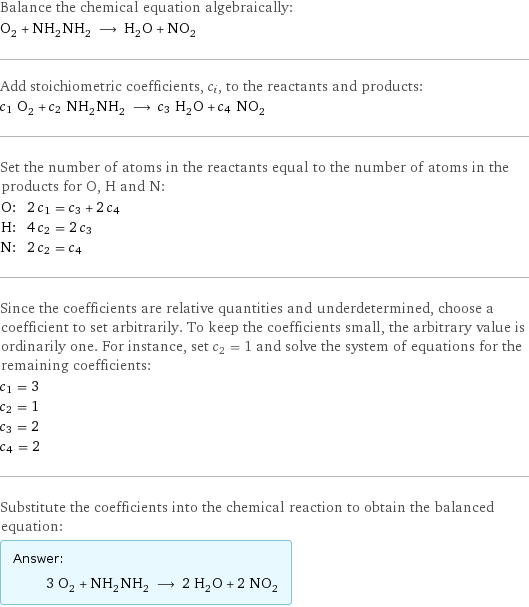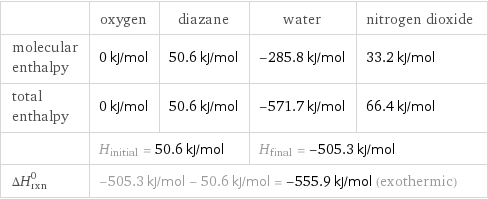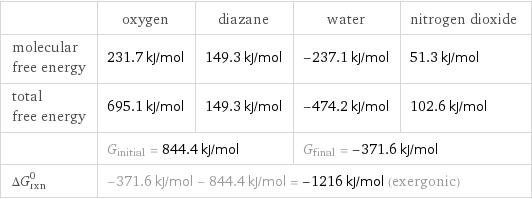Input interpretation

O_2 oxygen + NH_2NH_2 diazane ⟶ H_2O water + NO_2 nitrogen dioxide
Balanced equation

Balance the chemical equation algebraically: O_2 + NH_2NH_2 ⟶ H_2O + NO_2 Add stoichiometric coefficients, c_i, to the reactants and products: c_1 O_2 + c_2 NH_2NH_2 ⟶ c_3 H_2O + c_4 NO_2 Set the number of atoms in the reactants equal to the number of atoms in the products for O, H and N: O: | 2 c_1 = c_3 + 2 c_4 H: | 4 c_2 = 2 c_3 N: | 2 c_2 = c_4 Since the coefficients are relative quantities and underdetermined, choose a coefficient to set arbitrarily. To keep the coefficients small, the arbitrary value is ordinarily one. For instance, set c_2 = 1 and solve the system of equations for the remaining coefficients: c_1 = 3 c_2 = 1 c_3 = 2 c_4 = 2 Substitute the coefficients into the chemical reaction to obtain the balanced equation: Answer: | | 3 O_2 + NH_2NH_2 ⟶ 2 H_2O + 2 NO_2
Structures

+ ⟶ +
Names

oxygen + diazane ⟶ water + nitrogen dioxide
Reaction thermodynamics
Enthalpy

| oxygen | diazane | water | nitrogen dioxide molecular enthalpy | 0 kJ/mol | 50.6 kJ/mol | -285.8 kJ/mol | 33.2 kJ/mol total enthalpy | 0 kJ/mol | 50.6 kJ/mol | -571.7 kJ/mol | 66.4 kJ/mol | H_initial = 50.6 kJ/mol | | H_final = -505.3 kJ/mol | ΔH_rxn^0 | -505.3 kJ/mol - 50.6 kJ/mol = -555.9 kJ/mol (exothermic) | | |
Gibbs free energy

| oxygen | diazane | water | nitrogen dioxide molecular free energy | 231.7 kJ/mol | 149.3 kJ/mol | -237.1 kJ/mol | 51.3 kJ/mol total free energy | 695.1 kJ/mol | 149.3 kJ/mol | -474.2 kJ/mol | 102.6 kJ/mol | G_initial = 844.4 kJ/mol | | G_final = -371.6 kJ/mol | ΔG_rxn^0 | -371.6 kJ/mol - 844.4 kJ/mol = -1216 kJ/mol (exergonic) | | |
Entropy

| oxygen | diazane | water | nitrogen dioxide molecular entropy | 205 J/(mol K) | 121 J/(mol K) | 69.91 J/(mol K) | 240 J/(mol K) total entropy | 615 J/(mol K) | 121 J/(mol K) | 139.8 J/(mol K) | 480 J/(mol K) | S_initial = 736 J/(mol K) | | S_final = 619.8 J/(mol K) | ΔS_rxn^0 | 619.8 J/(mol K) - 736 J/(mol K) = -116.2 J/(mol K) (exoentropic) | | |
Equilibrium constant
![Construct the equilibrium constant, K, expression for: O_2 + NH_2NH_2 ⟶ H_2O + NO_2 Plan: • Balance the chemical equation. • Determine the stoichiometric numbers. • Assemble the activity expression for each chemical species. • Use the activity expressions to build the equilibrium constant expression. Write the balanced chemical equation: 3 O_2 + NH_2NH_2 ⟶ 2 H_2O + 2 NO_2 Assign stoichiometric numbers, ν_i, using the stoichiometric coefficients, c_i, from the balanced chemical equation in the following manner: ν_i = -c_i for reactants and ν_i = c_i for products: chemical species | c_i | ν_i O_2 | 3 | -3 NH_2NH_2 | 1 | -1 H_2O | 2 | 2 NO_2 | 2 | 2 Assemble the activity expressions accounting for the state of matter and ν_i: chemical species | c_i | ν_i | activity expression O_2 | 3 | -3 | ([O2])^(-3) NH_2NH_2 | 1 | -1 | ([NH2NH2])^(-1) H_2O | 2 | 2 | ([H2O])^2 NO_2 | 2 | 2 | ([NO2])^2 The equilibrium constant symbol in the concentration basis is: K_c Mulitply the activity expressions to arrive at the K_c expression: Answer: | | K_c = ([O2])^(-3) ([NH2NH2])^(-1) ([H2O])^2 ([NO2])^2 = (([H2O])^2 ([NO2])^2)/(([O2])^3 [NH2NH2])](../image_source/7640583b0806ef3956bd60fa090e6d0e.png)
Construct the equilibrium constant, K, expression for: O_2 + NH_2NH_2 ⟶ H_2O + NO_2 Plan: • Balance the chemical equation. • Determine the stoichiometric numbers. • Assemble the activity expression for each chemical species. • Use the activity expressions to build the equilibrium constant expression. Write the balanced chemical equation: 3 O_2 + NH_2NH_2 ⟶ 2 H_2O + 2 NO_2 Assign stoichiometric numbers, ν_i, using the stoichiometric coefficients, c_i, from the balanced chemical equation in the following manner: ν_i = -c_i for reactants and ν_i = c_i for products: chemical species | c_i | ν_i O_2 | 3 | -3 NH_2NH_2 | 1 | -1 H_2O | 2 | 2 NO_2 | 2 | 2 Assemble the activity expressions accounting for the state of matter and ν_i: chemical species | c_i | ν_i | activity expression O_2 | 3 | -3 | ([O2])^(-3) NH_2NH_2 | 1 | -1 | ([NH2NH2])^(-1) H_2O | 2 | 2 | ([H2O])^2 NO_2 | 2 | 2 | ([NO2])^2 The equilibrium constant symbol in the concentration basis is: K_c Mulitply the activity expressions to arrive at the K_c expression: Answer: | | K_c = ([O2])^(-3) ([NH2NH2])^(-1) ([H2O])^2 ([NO2])^2 = (([H2O])^2 ([NO2])^2)/(([O2])^3 [NH2NH2])
Rate of reaction
![Construct the rate of reaction expression for: O_2 + NH_2NH_2 ⟶ H_2O + NO_2 Plan: • Balance the chemical equation. • Determine the stoichiometric numbers. • Assemble the rate term for each chemical species. • Write the rate of reaction expression. Write the balanced chemical equation: 3 O_2 + NH_2NH_2 ⟶ 2 H_2O + 2 NO_2 Assign stoichiometric numbers, ν_i, using the stoichiometric coefficients, c_i, from the balanced chemical equation in the following manner: ν_i = -c_i for reactants and ν_i = c_i for products: chemical species | c_i | ν_i O_2 | 3 | -3 NH_2NH_2 | 1 | -1 H_2O | 2 | 2 NO_2 | 2 | 2 The rate term for each chemical species, B_i, is 1/ν_i(Δ[B_i])/(Δt) where [B_i] is the amount concentration and t is time: chemical species | c_i | ν_i | rate term O_2 | 3 | -3 | -1/3 (Δ[O2])/(Δt) NH_2NH_2 | 1 | -1 | -(Δ[NH2NH2])/(Δt) H_2O | 2 | 2 | 1/2 (Δ[H2O])/(Δt) NO_2 | 2 | 2 | 1/2 (Δ[NO2])/(Δt) (for infinitesimal rate of change, replace Δ with d) Set the rate terms equal to each other to arrive at the rate expression: Answer: | | rate = -1/3 (Δ[O2])/(Δt) = -(Δ[NH2NH2])/(Δt) = 1/2 (Δ[H2O])/(Δt) = 1/2 (Δ[NO2])/(Δt) (assuming constant volume and no accumulation of intermediates or side products)](../image_source/f180c0cc9fa49442036bb15906917f3a.png)
Construct the rate of reaction expression for: O_2 + NH_2NH_2 ⟶ H_2O + NO_2 Plan: • Balance the chemical equation. • Determine the stoichiometric numbers. • Assemble the rate term for each chemical species. • Write the rate of reaction expression. Write the balanced chemical equation: 3 O_2 + NH_2NH_2 ⟶ 2 H_2O + 2 NO_2 Assign stoichiometric numbers, ν_i, using the stoichiometric coefficients, c_i, from the balanced chemical equation in the following manner: ν_i = -c_i for reactants and ν_i = c_i for products: chemical species | c_i | ν_i O_2 | 3 | -3 NH_2NH_2 | 1 | -1 H_2O | 2 | 2 NO_2 | 2 | 2 The rate term for each chemical species, B_i, is 1/ν_i(Δ[B_i])/(Δt) where [B_i] is the amount concentration and t is time: chemical species | c_i | ν_i | rate term O_2 | 3 | -3 | -1/3 (Δ[O2])/(Δt) NH_2NH_2 | 1 | -1 | -(Δ[NH2NH2])/(Δt) H_2O | 2 | 2 | 1/2 (Δ[H2O])/(Δt) NO_2 | 2 | 2 | 1/2 (Δ[NO2])/(Δt) (for infinitesimal rate of change, replace Δ with d) Set the rate terms equal to each other to arrive at the rate expression: Answer: | | rate = -1/3 (Δ[O2])/(Δt) = -(Δ[NH2NH2])/(Δt) = 1/2 (Δ[H2O])/(Δt) = 1/2 (Δ[NO2])/(Δt) (assuming constant volume and no accumulation of intermediates or side products)
Chemical names and formulas

| oxygen | diazane | water | nitrogen dioxide formula | O_2 | NH_2NH_2 | H_2O | NO_2 Hill formula | O_2 | H_4N_2 | H_2O | NO_2 name | oxygen | diazane | water | nitrogen dioxide IUPAC name | molecular oxygen | hydrazine | water | Nitrogen dioxide